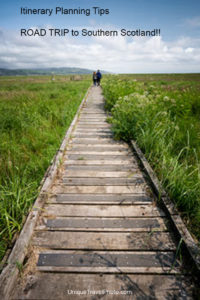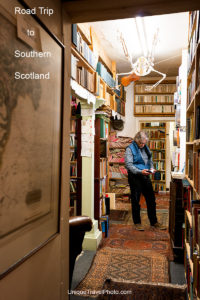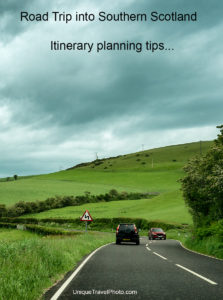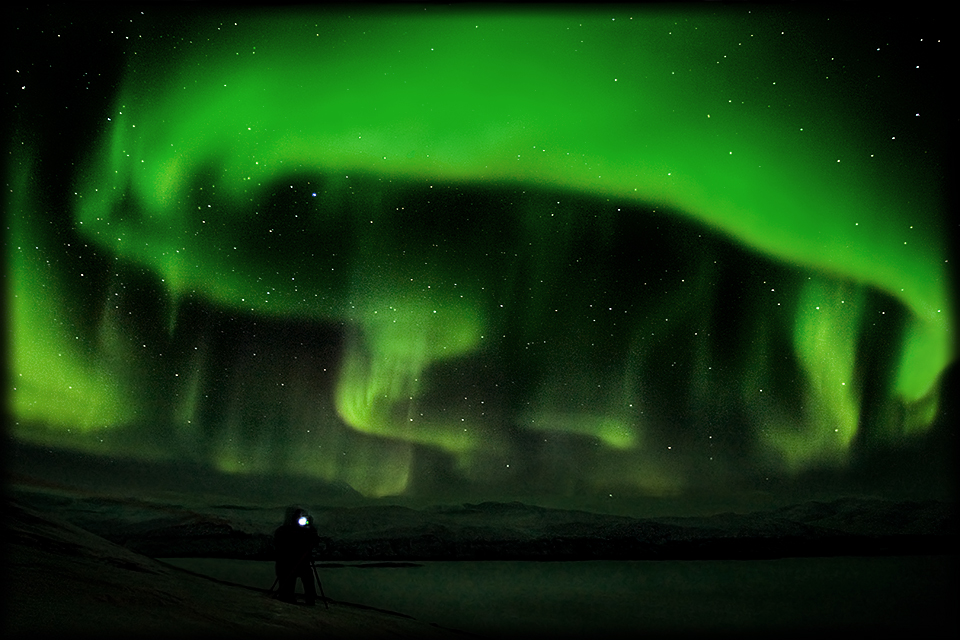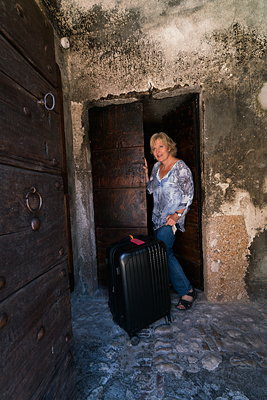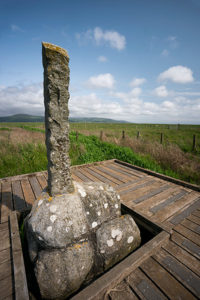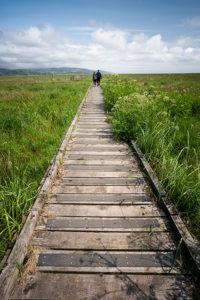
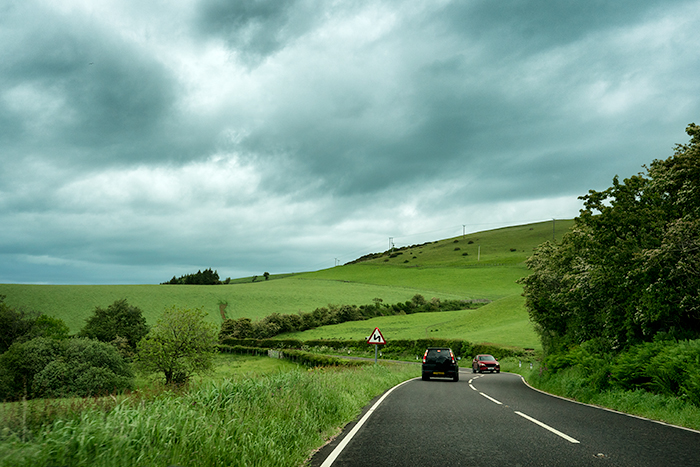
This is an overview of our 3 night itinerary on a road trip into southern Scotland from Edinburgh to Glasgow, concentrating on the Dumfries & Galloway area and the coastal west. Despite its proximity to the Scottish capital and England’s Lake District, this region sees the fewest tourists in the country…which appealed to me.
If you like pastoral scenes with rolling green hills dotted with coos and ewes…you will love this gorgeous countryside!
But what is there to see and do?
Lots actually. For starters there are medieval castles, abbey ruins, fortified towers, viaduct bridges, seaside towns, the National Booktown, Celtic crosses found in the birthplace of Christianity, standing stones, gardens, beautiful beaches and rocky coasts, nature reserves, long distance hiking trails, mountain biking, star gazing in a dark sky park, and several places of interest for Robert Burns fans.
Driving in the South
Even though there are buses and trains that travel through this region, a car really is necessary if you want to explore sites in the south. So let’s address basics first.

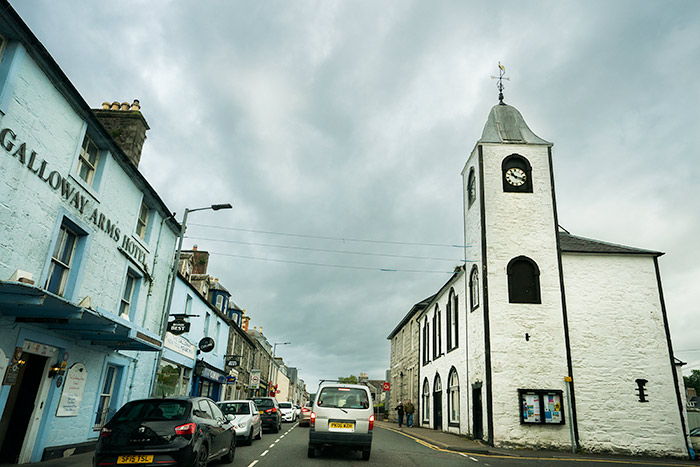
Driving in Scotland requires driving on the left. (When approaching intersections it helps to chant, “Look right, drive left” until you get the hang of it.) Most car rentals are manual, making it awkward to shift gears manually in the opposite hand that you’re used to. It’s worth the extra expense to rent an automatic to save yourself some stress!
Car rental tips:
Rent the smallest car you can squeeze your stuff inside. Your Jeep back home will feel like a Monster Truck on these narrow roads. Buy a GPS pre-loaded with UK maps and bring it from home. If your credit card covers insurance of your rental, ask them to email you a letter detailing the coverage so you can print it and give to the car rental agency. Otherwise you may be forced to buy the car rental’s insurance if you cannot show proof. (This happened to the lady next to us, which doubled her car rental rate.)
Roads
Main roads heading south from Edinburgh are paved 2 way roads, not divided highways (dual carriages). The lanes seem narrower than back home in the US, and most of the roads lack shoulders. Which means it can feel scary close to the edge. Expect narrow winding roads that twist and turn abruptly as you edge the Borders, slow moving tractors, commuters and impatient drivers that attempt to pass even on blind curves. Take care!

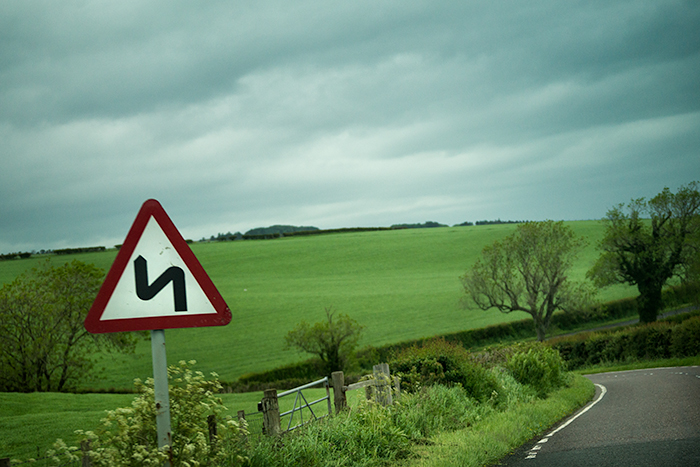
Roundabouts
And then there are the roundabouts. Oh, those roundabouts. The double-lane loops are easy, but those three and four-lane loops are a bit confusing. The tricky part is that you need to know—before you jump into the circle—which exit you will be taking—is it the 1st, 2nd, 3rd, 4th—so that you enter the correct lane. This is where a GPS really shines. You don’t want to be scanning for signs when you need to concentrate on the moving cars. There’s a specific method to the madness, all communicated through the indicators (blinkers). Do yourself a favor and watch YouTube videos about driving in advance.
Thankfully most of the busier, three and four-lane roundabouts are located near the larger cities, where you have to wait your turn for an opportunity to jump in. Rural roundabouts generally have 2 lanes with no wait.
You would think that highways are free from roundabouts. But, not so. Along the west coast, heading toward Glasgow especially, they occurred so frequently it felt like we were on Candid Camera. We’d finish one roundabout and the GPS would say, “In .7 miles enter a roundabout.” You’ve got to be kidding! No joke. In fairness, at times they stretched out to 2 miles.
All in all, driving in the south was less stressful than driving on the Isle of Skye and Lewis on their single track roads with “Passing Places.” Roads in the South were in great condition, signage made it easy to find locations and visit attractions, and those beautiful landscapes, so green and serene, were a joy to drive through.
Just take your time, be safe, and remember… Look right, drive left… 😉
Itinerary Planning
So where should you go?
It’s easy to over plan and jam your itinerary too full. I know. There’s so much to see and do that I was guilty of that on this road trip too. We ended up seeing about half of what we intended–due to running out of time, not energy. It took a lot longer to get anywhere than we expected, so we couldn’t get to some attractions before they closed at 5pm.
In hindsight, I would recommend selecting just 2-3 highlights per day plus travel time so you don’t feel rushed. Use Google maps to calculate time estimations between desired destinations, but add plenty of padding to allow for slower driving on the narrow winding roads and the speed-zapping roundabouts.
Maps…so helpful for planning! I like studying a large map spread out my desk while Google Maps is displayed on my computer. (This was my favorite Scotland map.) That way you can see distances and decide which place to stay depending on your interests.
These towns make good bases: Dumfries, Wigtown and Ayr
DUMFRIES
Roughly 2 hours south of Edinburgh, Dumfries makes a great base for the 1st night. There are 2 ways to get here—driving directly south of Edinburgh OR veering southeast to visit attractions in the Borders. Interesting sites to see along the way, no matter which route you decide to take.
A. Directly South:
Edinburgh to Dumfries on A701/A703 (Google maps: 2 hr 30 min)
Attractions along the way:
- Rosslyn Chapel: Familiar to fans of the DaVinci Code, you’ll recognize this famous place rumored to hide relics of the Holy Grail. You could spend an hour just looking at the mysterious symbols, carvings, pillars and gargoyles inside this Gothic masterpiece.

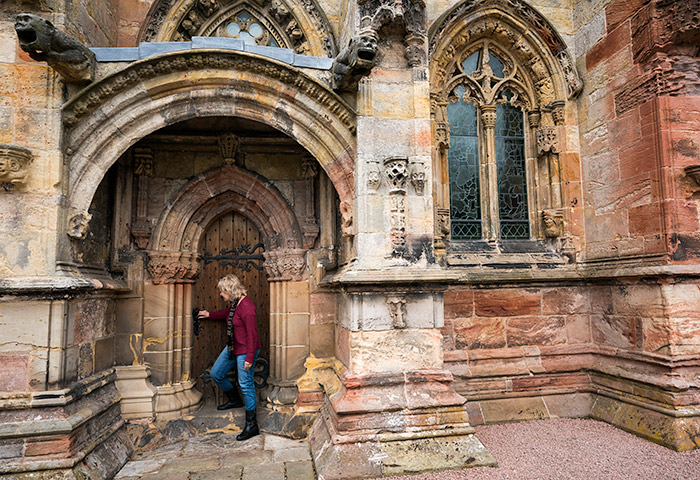
- Traquair House: Originally a royal hunting lodge visited by many kings and queens, this mansion dating from 1107 has been inhabited by the Stuart family since 1491. During the Jacobite uprising, the Stuart lord locked the gate when Prince Bonnie Charlie left on horseback, promising to open it only when the Stuarts were restored to the Crown. Largest outdoor maze in Scotland. Tour gardens and interior of this mansion where Mary Queen of Scots once stayed. You, too, can book an overnight room.
OR…
B. Southeast/Borders:
Edinburgh through the Borders to Dumfries on A68/A6091/A708/A701 (110 miles, Google Maps: 3 hrs)
Attractions in the Borders along the way:
- Dryburgh Abbey: the most evocative ruin according to those who visit, burial place of Sir Walter Scott.
- Melrose Abbey: pink hued monastery ruins with grand arches and carvings of pigs playing bagpipes on the roof.
- Abbotsford House: Baroque mansion, amazing library & lavish gardens of author Sir Walter Scott.
Dumfries is the largest town in the southwest. Home to 30,000 people, this market town sits on the Solway Firth. Perhaps its most famous resident was poet Robert Burns who lived in this brick home until his death. Fans of the National Bard will want to check out these Dumfries sites associated with his life: Robert Burns Centre (in a watermill) exhibits his belongings and manuscripts, Ellisland Farm where he lived and worked, the Robert Burns House where the poet spent his last years and the nearby cemetery at St. Michael’s church. (Read about his life and the sites on my post here.)

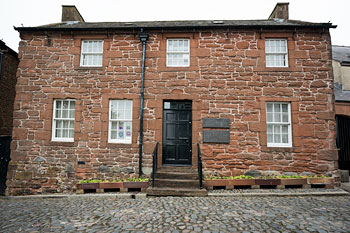

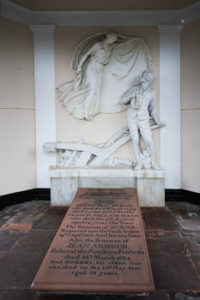
My top 3 picks south of Dumfries (spreading out like a spider in different directions):
- Caerlaverock Castle: unique triangular fortress in a moat, 9 miles south on A701 (Google map: 20 min drive) Although perpendicular to the Sweetheart Abbey a river separates them, so you have to backtrack to Dumfries to reach the other.

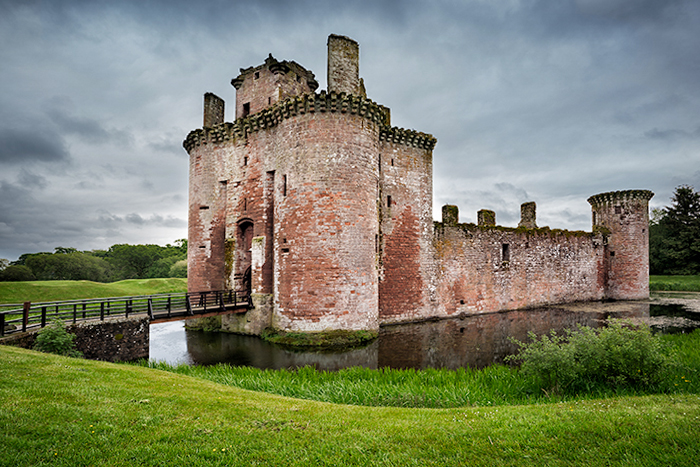
- Sweetheart Abbey: pink hued monastery ruins with a fascinating story. Drive 8 miles south on A710 (Google map: 15 min drive)
- Threave Castle: ring a bell to be rowed across River Dee to visit this stone castle. How romantic! Drive 30 miles SW on A75 (Google map: 51 minutes)
Read about my visit to Caerlaverock Castle here.
WIGTOWN

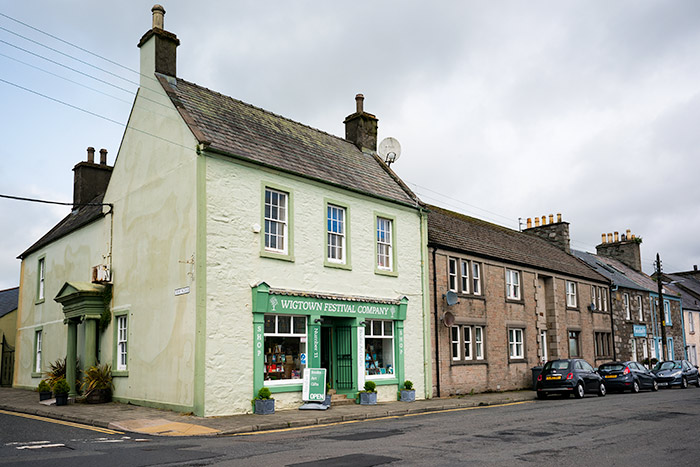
Located 54 miles (Google map: 1.5 hours) southwest of Dumfries.
This tiny seaside town is Scotland’s National Book Town, so you know there’s lots of bookstores. One of 12 independent bookstores offers tourists an opportunity to run a bookshop for a week by renting the apartment above through Air B&B. The busiest time to visit is Autumn when literary fans flock here to attend the popular Book Festival. Wigtown is also known for the Covenanter martyrs who died tied to a stake in a rising tide in 1685. A trail leads from their grave to a monument at the stake now sitting amid marshlands, as the River Bladnoch has changed course.
Attractions north of Wigtown:
- Dark sky park: three visitor centers help interpret night skies at the Galloway Forest Park. Located 16 miles north on A712/A714.
- 7stanes Mountain Biking: 400 km of singletrack for all abilities with bike rentals available at Kirroughtree and Newton Stewart.
Attractions south of Wigtown:
- Sorbie Tower: fortified tower house from 16th century halfway between Wigtown and Whithorn (a quick look-see)
- Whithorn Priory: visit the birthplace of Christianity, see ancient Celtic crosses near the 1st Christian church in Scotland. Located 10 miles (20 minutes) south on A746.
- St. Ninian’s chapel: walk to this 5th century seaside ruin on the Isle of Whithorn, or venture further to his cave. Six miles further south from Whithorn on the tip of the coast.

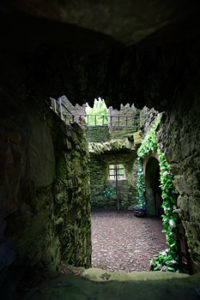

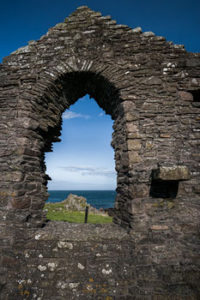

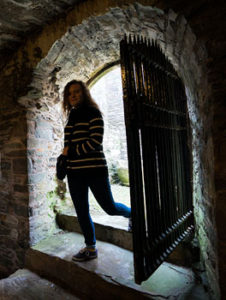
AYR

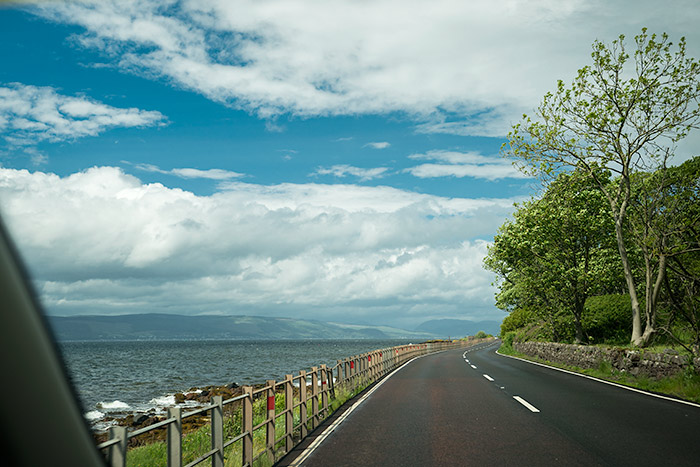
Located on the southwest coast, this seaside town of 50,000 people is 37 miles from Glasgow. Famous for being the birthplace of poet Robert Burns in Alloway, the region of Ayr has other historical buildings and a long sandy beach.
Attractions south of Ayr:
- Culzean Castle: Elegant clifftop castle full of period furniture has 6 guestrooms, an Adam designed oval staircase, walled gardens, museums, and even sea caves. Open April to October only. Located 12 miles south of Ayr, and 48 miles (1 hr 15 min) north of Wigtown on A714/A77.
- Robert Burns Birthplace Museum, his humble cottage, pretty stone Brig-O-Doon, and Kirk where his father is buried—so many sites are tied to Scotland’s favorite bard. Great cafe too! Located in Alloway, 2.6 miles south of Ayr.

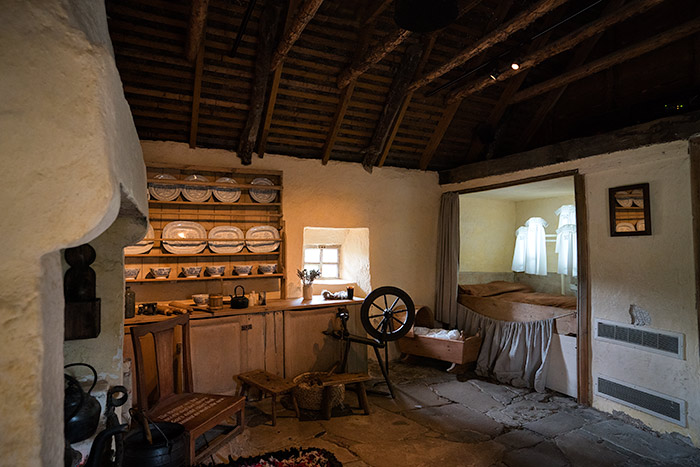
Special Lodging north of Ayr:
- Castle Levan: Explore the nooks and crannies, spiral stairway, arrow slit windows, turrets, 4-foot walls, conservatory and battlements at the top of this defensive fortress overlooking the Firth of Clyde. Located smack in the middle of a 21st c neighborhood, Castle Levan is a unique historic property, recently voted as the Quirkiest place to stay. We loved it here! Located in Gourock, 47 miles north of Ayr (1 hr 10 min), and 30 miles (45 minutes) west from Glasgow.

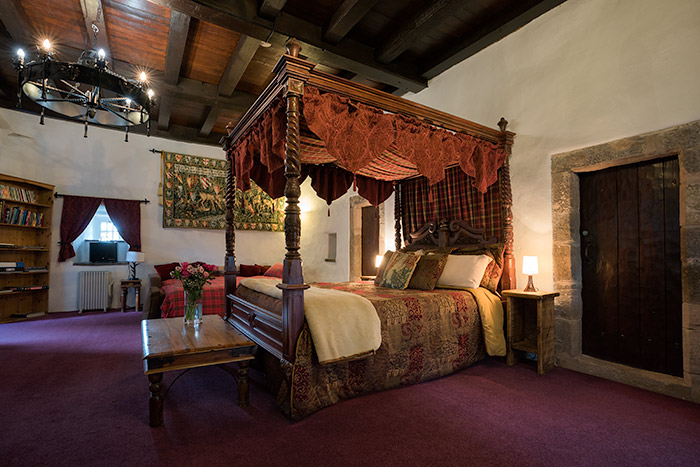
Read about our Castle Levan stay here!
Our Experience on our Road Trip into Southern Scotland
We had intended to visit Rosslyn while in Edinburgh, but because of flight delays we lost 3 days there so had to omit time in the Borders.
Day One: We didn’t get out of the car rental agency till after 1:30pm. We drove directly south of Edinburgh toward Dumfries, stopping at Rosslyn Chapel only 30 minutes (way too brief) yet didn’t make it to Caerlaverock Castle before closing time to tour inside. We then backtracked to Dumfries to see Burn’s home and burial before driving 1.5 hours onward to Wigtown where we spent 2 nights.
Pressed for time we didn’t get to stop at either the Sweetheart Abbey or Threave Castle–2 of the places I really wanted to see. Driving straight to Wigtown from Dumfries, it was 8pm when we arrived, and the restaurants were closed except for the tavern of the Craft Hotel (our host called to ask if they were still serving food). Great steak pies, a cozy atmosphere and our first taste of haggis. We stayed at the Craigmont Inn, which I highly recommend for their friendly hosts, comfy rooms, made-to-order breakfasts and brownies to go.

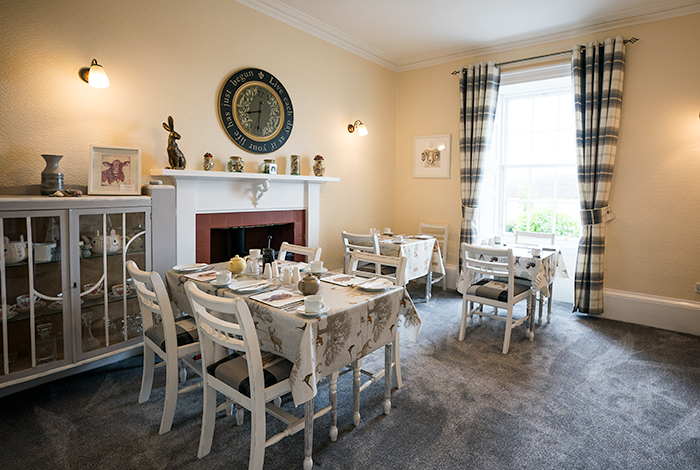
On a personal level, we were following crumbs on my husband’s ancestral trail which led us to Wigtownshire. Internet searches and dusty books steered us into believing that his great-great-great-great-grandfather was a preacher in the Wigtown Parish church where he was buried. So we arranged our itinerary to attend that church Sunday morning and meet with a local historian about his ancestors. She was extremely helpful showing us documents, from Coventanter records to books that detailed every gravestone in the surrounding towns. Unfortunately we came home more confused than ever, as the historian could not place him in the context of being a preacher at the Wigtown Parish church nor buried in the cemetery. But it was still an interesting goose chase…and we really loved quaint little Wigtown.

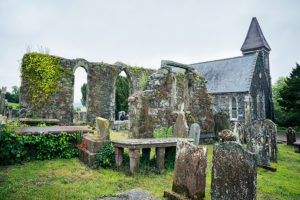

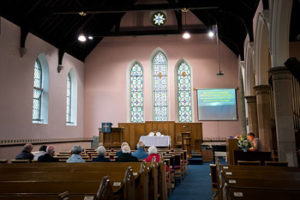
Day 2: We attended church (imagining Dave’s ancestor as the minister), stayed to talk to the warm friendly locals afterward over coffee and cake, and poked around the cemetery looking for names on mossy stones surrounding the ruins of the ancient church. Knowing we had several hours to explore before we met with the historian at 8:30pm, we drove to the next village for “Sunday carving” buffet, browsed a few bookstores in Wigtown before walking the Martyr’s trail and walking to the bird hide along the river.
Mid-afternoon we drove south to Whithorn to visit the Priory museum and Celtic crosses, then drove onward to the Isle of Whithorn to hike out to St. Ninian’s chapel (the bare ruin far more interesting after hearing who the historian believes he is!) and stopped briefly at Sorbie Tower along the way home. Busy day but didn’t feel tired until jetlag suddenly struck at 9:30pm (when I struggled to fight the embarrassing nods during our time with the fascinating informative historian. So very sorry, it wasn’t you!)

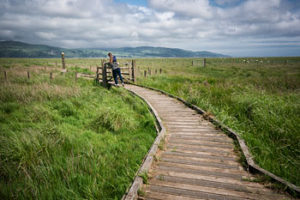

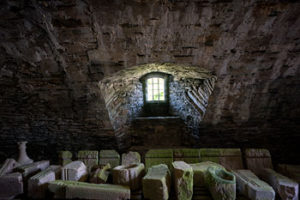
Day 3: Since most of the bookstores were closed on Sunday, we spent time browsing for books Monday morning before driving straight up to Alloway to visit the Burns sites. Spent a couple hours sightseeing plus enjoyed a ploughman’s lunch at the excellent museum’s cafe. The pacing was perfect this day. We drove up along the coast to Gourock where we checked into Levan Castle at 4pm. A knight in armor, spiral stairway, soaking tub, and tartan draped four-poster bed awaited…oh, what a romantic place to spend the night! We walked along the shore that evening after dinner watching the rays hit the mountains across the Firth of Clyde.

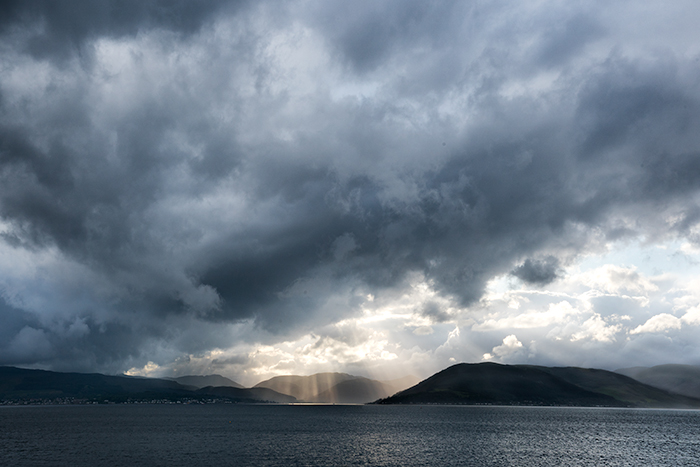
Sleepy villages, castle ruins, historic places and scenic coasts provided lots of variety to our road trip into southern Scotland. Three days simply wasn’t enough. Next time, I’d plan a week.
Oh, and a quick mention about costs.
Admission to the historic sites is the same around the country £6 adults (more for bigger properties), but you will save lots of money on lodging in the south! For example, rooms that fit 2 adults and a child in Old Edinburgh for a 3 star hotel room in late May were £666 a night, but the cost for the 3 of us in a large family room with a huge buffet breakfast at the Craigmont was just £85 a night (and no rate hike in summer). And what about the castle stay in the huge laird’s suite at the top of the fortress? £175 for 3 people, and this rate included a made to order scrumptious breakfast in the original feasting hall!
So compared to 3 nights in Edinburgh (3 star hotel) at £666 a night = £1998… we stayed 3 nights in southern Scotland (beautiful inn & castle) for a total of £345. Yep. Quite a SIGNIFICANT savings!!
So what are you waiting for? This region is just waiting to be explored…
Just don’t forget a good map! Buy our favorite Scotland map here.
And here’s a map of hotels in the South to help you plan your road trip… What area sounds most interesting to you?
Want to save post for later? Save a pic below to your Pinterest travel board…

